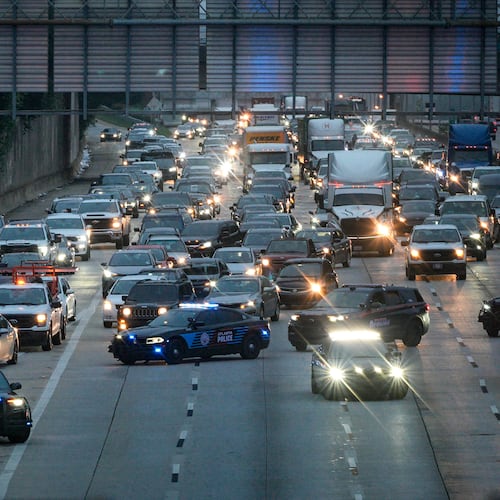Tragedy befell Atlanta traffic poignantly on two different mornings last week. The most gruesome of the two was in Marietta: A woman with a flat tire got rear-ended and run over last Tuesday in the 5 a.m. hour. Then a truck and trailer hit the second car, ejecting the second driver, who was then run over. The horrendous scene shut down I-75/northbound at the South 120 Loop (Exit 263) for about five hours.
WSB Triple Team Traffic’s Ashley Frasca actually saw the collisions happen on our WSB Jam Cams and saw the original stall on the left shoulder of I-75/nb on her way to work. She called 911 when she saw the vicious crashes and even spoke to Marietta PD officers after the fact, since she was a witness to the carnage.
In Frasca’s correspondence with Sgt. Brian Honea and Ofc. Nick St. Onge, they offered four things both stranded motorists and the drivers around them should do in these situations.
1. Steer and clear movable vehicles
Georgia law is clear that motorists that are supposed to move their crashed or stalled cars from travel lanes, if the vehicles are able. This not only improves traffic flow, but it makes the entire scene safer for those involved, those responding, and the vehicles passing by, Marietta PD told Frasca.
The heavier traffic is, the harder steering and clearing becomes, but many drivers do not even attempt to get over. Sitting in travel lanes means first responders likely have to block multiple lanes to clear the problem, worsening the traffic delays.
Staying in the middle of traffic, too, increases the likelihood of a collision. Problems cause problems, especially in the dark hours and when traffic is whizzing by at high speeds.
2. Stay in, move to the right
The I-75 melee in Cobb County might have played out differently, had the first driver stayed in their vehicle and tried to move it to the right shoulder.
As crazy as this could sound, the safest place for a stranded commuter, stuck in travel lanes or not, is inside the car. At least, in that instance, the driver is surrounded by a roll cage, windows, airbags, and even a seatbelt. But imagine the difference between a driver’s car being hit by another car while sitting in it, and that driver or their car getting hit while standing next to it.
An example of this was in the fall of 2021, when someone slammed into vehicles on the right shoulder and threw a woman standing outside those cars off of the bridge. She miraculously survived.
When drivers are clearing their vehicles to emergency lanes, they really should try to get those vehicles to the right shoulder.
“When you get in an accident or a stall, get to the right shoulder,” Frasca explained. “Often the left shoulder is too narrow.”
This was definitely the case on I-75 in Marietta last week.
Also, if an incident is on the left shoulder, the arriving first responders later have to block lanes to move it safely to the right side.
3. Yield to first responders
“When an emergency vehicle is behind you in the left lane with lights and sirens flashing, move to the right and do not slam on your brakes,” Frasca said the officers told her. “They’re heading to an emergency.”
The longer their response time is delayed by stubborn and inattentive drivers, the longer the backup can last and, more importantly, precious potentially life-saving minutes are lost.
And drivers should not just freak out and stop when they see approaching lights. That just blocks their path. Instead, people should move to the right and clear a lane.
4. Do not block the shoulders
“Do not drive on the emergency shoulder; police and first responders need that,” Frasca said. She, the WSB Traffic Team, and I see this violated all the time.
People gum up the emergency lanes in desperate attempts to pass traffic. And they usually do this when the entire road is shut down anyway, meaning they just get stuck in a different spot.
And that spot is exactly where emergency vehicles need to drive so they can respond to the crash and clear it more quickly.
Police or HERO operators will sometimes direct traffic to drive on a shoulder, if that is the only passable space. But by then, most responders have actually arrived. They also will sometimes counter-flow traffic up entrance ramps or allow people to turn around in a grassy median to escape backups. Drivers should never do this on their own — only when directed.
When drivers decide to cut across restricted areas or drive in the wrong direction, they can create more safety issues and potentially more traffic. Oftentimes, when the first renegade tries this on their own, it is monkey see, monkey do.
So take these ideas to heart: clear vehicles to the right, stay inside them if in a lane or on a shoulder, yield to first responders, and keep the emergency lanes open. This is sage advice from the people that put their lives on the line to respond to these problems and the people that report on them every day.
Doug Turnbull, the PM drive Skycopter anchor for Triple Team Traffic on 95.5 WSB, is the Gridlock Guy. Download the Triple Team Traffic Alerts App to hear reports from the WSB Traffic Team automatically when you drive near trouble spots. Contact him at Doug.Turnbull@cmg.com.
About the Author
The Latest
Featured
